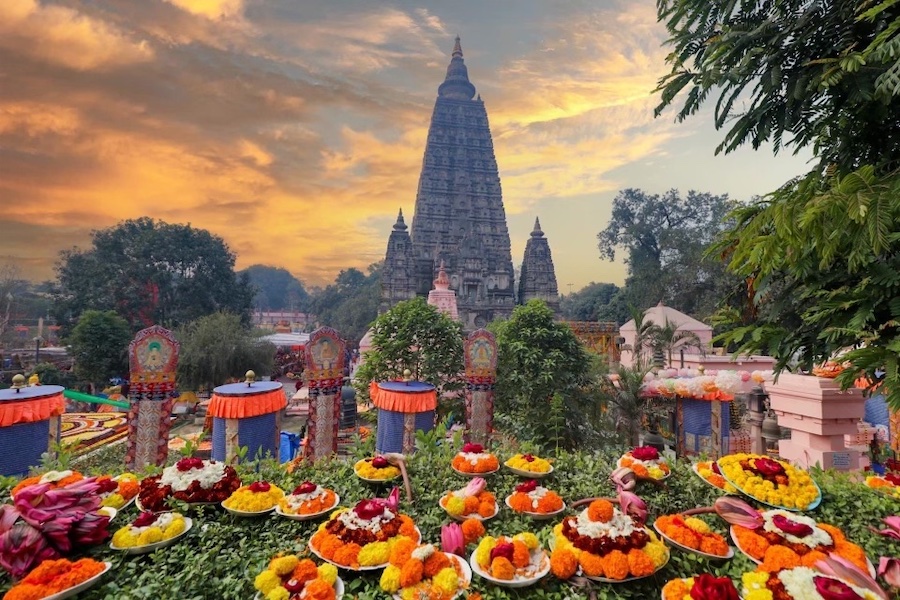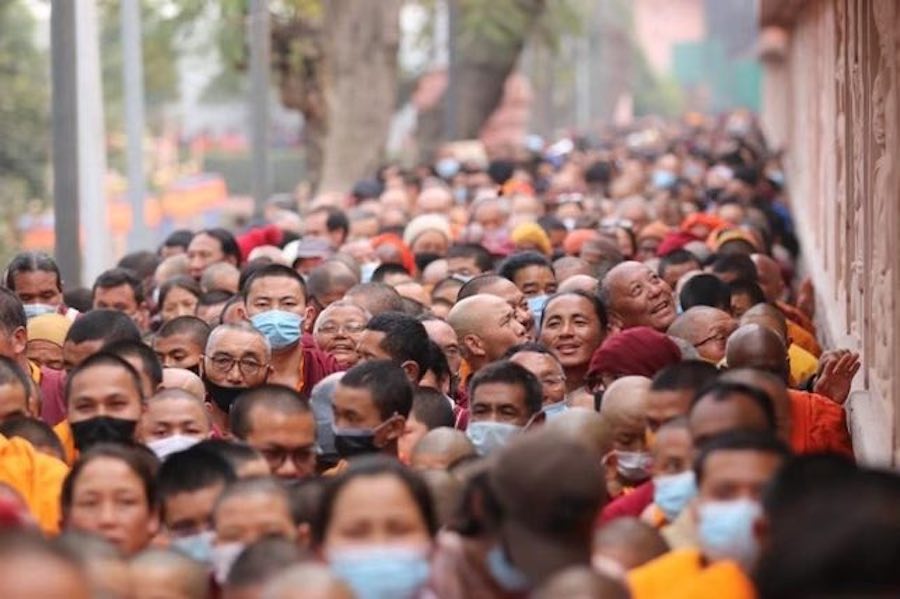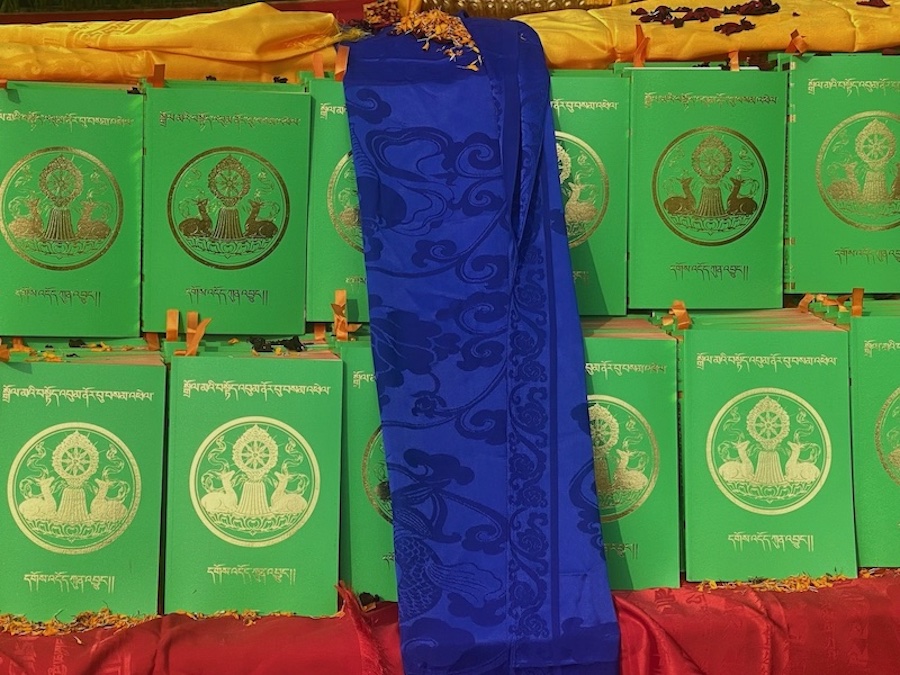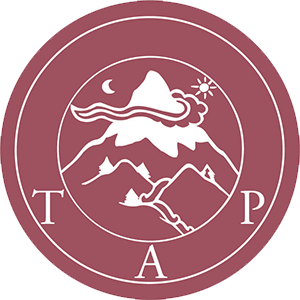Thank you again from all of us at TAP for your contributions and support. May our efforts together be far-reaching, protecting and supporting this wisdom transmission, for the benefit of as many beings as possible, for generations to come.
2023 World Peace Ceremony: Interviews with Lama Palzang and Pema Gellek
The 2023 World Peace Ceremony (Nyingma Monlam Chenmo) was held from January 22nd – 31st. During these ten days, over 83,000 texts were given away, thanks to the generosity of Tibetan Aid Project donors; together we sent six shipping containers filled with texts this year.
Over 12,000 participants came together for this gathering—about 8,000 monks and nuns and 4,000 lay pilgrims from all across the Himalayan regions, including Nepal, Ladakh, Bhutan, Sikkim, and also from Tibetan settlements and monasteries in different states of India.
After the challenges and losses of the last two years, the atmosphere was charged with appreciation and joy for this precious opportunity to come together in community and engage deeply in practice.

Lama Palzang, who leads the on-the-ground organization of the annual distribution, responded to a few questions about how this year’s activities unfolded:
What do you most appreciate about the ceremony?
Lama Palzang: The opportunity to serve those who participate in the ceremony at such a large scale, year after year, is extremely rare when you think about it. So many different offerings are made, and not just regular offerings, but these precious texts in all kinds of different categories. It’s an incredibly rare opportunity for an individual to be able to make offerings to 400-500 monasteries like this. I am serving as the link, so these offerings pass through my hands, and I feel very satisfied to be able to help make these gifts.
Any challenges?
Lama Palzang: No major challenge; whatever comes up we go through it, and we have experience doing this. However we have a limited time to do the distribution. Also it is very crowded, which we need to celebrate as that means more participants, however, navigating through the crowd can be tough. Of course Bodh Gaya is a sacred place, but the environmental factors—water, air, and sanitation can be difficult.
What is special about Bodh Gaya?
Lama Palzang: It is the most sacred place. The Buddha became enlightened here. We call it Dorje Den or the Vajrasana, and it is the only place on Earth that can withstand the tremendous energy of a Buddha awakening. It contains sacred energy, so when we read donor names, it is like sending positive energy to you, and all offerings and prayers here are amplified.
Anything else you’d like to share?
Lama Palzang: Thank you so much for your support. Otherwise these books wouldn’t make it here. They would be sitting in the US at Ratna Ling. Because of your support through TAP, it was possible to ship all the books to Bodh Gaya, and then distribute from there throughout the Himalayan regions. I am from Tibet, and I wish to say thank you very much for your support for the Tibetan culture. It takes the support of many people, and the effort of many people, to create such a positive result, to make an offering of these sacred texts into the right hands.

Pema Gellek, who is the director of TAP as well as an organizer of the distribution each year, also had a few words to share:
Can you tell us about the power of the ceremony?
Pema Gellek: Every day during the ceremony, millions of prayers are offered, and thousands of people are activating their highest aspirations. We pray for universal awakening, that the world be free from nuclear conflict and violence, for the health and flourishing of all countries and our living planet as a whole, and that all realms, including the animal realm, be free from suffering. As long as we are not yet enlightened, as long as we are still bound by ego, suffering, habitual patterns, Bodh Gaya is a crucial touchstone for aspirations and healing.
Given the urgency of the upheavals we are facing—the pandemic, violence, environmental change—each with powerful trajectories that seem beyond our control, we need to turn beyond the ordinary ways of solving problems. We see the consequences of a world left to its own devices, the limits of our knowledge when there are no guardrails of enlightened wisdom and compassion – the human and planetary suffering that results. These huge forces are rooted in the mind itself, in greed, hatred, confusion, ignorance, and they can only be healed in the mind.
Also, the Monlam reminds us that our highest values aren’t something that we just keep in our hearts and minds. We make offerings that connect us with other living beings. Generosity and this quality of sharing allows us to feel our interdependence with all beings.

Over ten different sets of books, some of which are collected works of a great master in 25 volume sets, were distributed.
How are texts chosen?
Pema Gellek: Long before production begins, Tarthang Tulku Rinpoche selects the texts for distribution from among the any precious manuscripts and texts in his libraries collected over fifty years; this treasury of books is Yeshe De’s major resource for preparing the books offered in Bodh Gaya. Rinpoche takes into account the most pressing religious and educational needs of monasteries and shedras in exile and Tibet.
Each year, he manages to identify texts, whether from his own library or research of other collections, that are rare and precious, something that even the most well-read of the Nyingma community may not have access to. There’s this dimension of surprise and awe, and a quality of discovery. The equivalent for our culture might be putting a spotlight on a relatively unknown but consequential treatise by Plato, or a philosopher of the Enlightenment period, or a commentary by Thomas Aquinas on the Bible, and making them available as part of a collection with that author’s other more well known works. When the Sangha receives this work, not only is it a testament to the scope of this knowledge tradition and restoring part of their heritage, but it also invites a conversation with these great masters across time, for these works represent understanding that speaks still to the human condition. Authentic wisdom remains relevant: it expresses truths of our humanity that go beyond time and culture.

What is the impact of the distribution?
Pema Gellek: Anyone who supports the text project is helping solve the problem of how this wisdom tradition could just fade away given all the challenges it faces. It will not survive on its own without a profound effort. The living tradition continues, but its vitality and diversity is dependent on this vast text tradition. Rinpoche and our organizations are ensuring that the living tradition is rooted in its heritage and in the vast libraries that are its inheritance; we are helping restore that connection and in a sense, help knit the holes and frayed ends of the fabric of this knowledge tradition back together.
You could imagine that if somehow our own intellectual tradition and culture underwent a major assault and genocide, perhaps different universities afterwards might rely on certain key texts, but lacking access to the whole library, suffer from atomization. We are fighting the demise of a wisdom tradition, through protecting the integrity of the whole text tradition, and by ensuring that the words are preserved and shared, widely, without sectarian bias. Then it’s up to the Sangha to study, practice, and embody these teachings.
We are all stakeholders in this – we can’t do it alone. This is heavy lifting, to try to save a tradition. There are those who are physically printing the books, binding them, trucking them to the shipping docks, those who are doing the fundraising, organizing, buying the necessary supplies, keeping the accounts; those who are typesetting, editing; those who distribute the books. It’s a tremendous orchestration of effort, this huge output of production is the culmination of a year-long preparation which involves so much work, heart, and sheer grit. Remember we have been doing this for 34 years now, it’s an immense commitment.
It’s so easy to destroy something; an extraordinarily rich culture of 1,400 years was almost wiped out when all of Tibet’s libraries and monasteries were destroyed in a short period of time. It takes much greater effort to build something back up and restore it.
The content of the books is precious, but these efforts honor more than that — it’s a testament to the power of caring, of love for the tradition. That’s what we strive to communicate year after year, and I believe, this deeper intention we convey is empowering and energizing for the recipients. It’s our commitment to the Sangha that is important, to demonstrate year after year, that they are absolutely worthy of such efforts. Someone has to make sure that this work is being done, and Rinpoche has put himself and our organizations in this position to fill a void and respond skillfully to the reality of the situation before us. It’s also central to our spiritual practice, to do all this work as volunteers, to practice pouring our energy into positive intentions and selfless action.
Generosity is part of the living tradition. The Buddha taught generosity as the first perfection of the six paramitas. That sets up the causes and conditions for our own education of mind and spiritual progress; the merit of that giving makes it possible for our own receiving of the tradition. This includes blessings of insight and wellbeing, something that you cannot quantify, but nevertheless it works; this cultivation of merit is ennobling, transformative, and it is a fundamental part of the path.
In spite of all the tumult in the world today, having just returned the ceremony, I am happy to share my sense that the Dharma is very much alive, and that the texts continue to play an essential role. Communal gathering is one of the charismatic qualities of these texts: they invite people to come together and read, recite, and pray in person.
I have attended and served at the ceremony 27 times now, and had the opportunity to watch young monks grow up, who now stand before me as Khenpos with their own students. The knowledge within these books is transformative; it upholds the wellbeing of the human spirit. Each book is a love letter to the future, an expression of caring, a message that we don’t have to suffer, that there are so many methods for waking up, and that being fully awake in the world is possible right now. With every book we put into the hands of practitioners, this is the living tradition we’re upholding.
